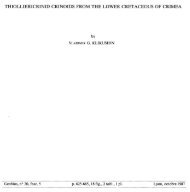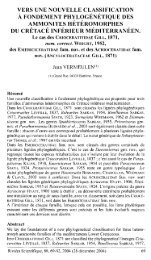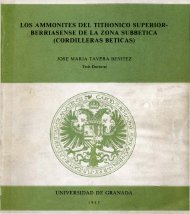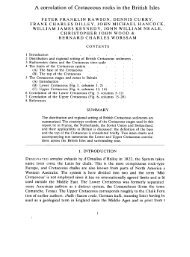New and poorly known Valanginian ammonites from South-West ...
New and poorly known Valanginian ammonites from South-West ...
New and poorly known Valanginian ammonites from South-West ...
Create successful ePaper yourself
Turn your PDF publications into a flip-book with our unique Google optimized e-Paper software.
<strong>New</strong> <strong>and</strong> <strong>poorly</strong> <strong>known</strong> <strong>Valanginian</strong> <strong>ammonites</strong> <strong>from</strong> <strong>South</strong>-<strong>West</strong> Crimea 105Remarks. Campylotoxia is close to Thurmanniceras Coss-MANN. 1901, Busnardoites NIKOLOV, 1966, SarasinellaUHLIG, 1905. Kilianella UHLIG, 1905, Neocomites UHLIG,1905 <strong>and</strong> Varlheideites RAWSON & KEMPER, 1978. It differs<strong>from</strong> the genus Thurmanniceras by a different constructionof cycles of ribbing, low rib br<strong>and</strong>ling <strong>and</strong>ventral tubercles, which are subparallel to the plane ofsymmetry already in the middle whorls. Campylotoxiais distinguished <strong>from</strong> Busnardoites s.s. by a differentstyle of ribbing in its inner whorls, by the absence of strongumbilical tubercles in the early whorls, by the flattening ofribs, by the smaller number of branches in bunches <strong>and</strong> byventro-lateral tubercles subparallel to the plane of symmetry.Sarasinella has well-marked lateral tubercles completelymissing in the early whorls of Campylotoxia. Kilianellahas deep constrict ions, high-branched ribs <strong>and</strong> largerounded ventro-lateral tubercles in the end of cycles ofribbing. The genus Neocomites has a different constructionof cycles of ribbing in the early whorls. The morphology ofthe middle whorls of Varlheideites RAWSON & KEMPER,1978 is close to Campylotoxia but the presence of frequentfine ribs in the inner whorls <strong>and</strong> the appearance oflateral<strong>and</strong> ventro-lateral tubercles, clearly distinguishes the newgenus.Sarasinella sp. aff. ambigua (COLLIGNON, 1962: p. 26,fig. 829} possibly belongs to Campylotoxia, because ofthe close style of ribbing, but it is distinguished by thepresence of weak constrictions, which appear in the adultwhorls.NIKOLOV (1977) was the first, to indicate the morphologicalspecificity of the "Hoplites" campylotoxusgroup. He included it in Busnardoites NIKOLOV, 1966.Close examination of the internal whorls of Busnardoites,available in our collection, has revealed theiressential differences. The revision of the campy.'-lotoxus group has shown that these <strong>ammonites</strong> have asufficiently specific morphology of ribbing, to allowthe separation of Campylotoxia as a new genus. Thisgenus occupies a well-defined position at the endof the Lower <strong>Valanginian</strong>. We assume after NIKOLOV(1977) that Campylotoxia is a direct descendant of Thurmanniceras<strong>and</strong> has great morphological resemblancewith it.Distribution. Lower <strong>Valanginian</strong>. Haploceras (Neolissoceras)salinarium Zone of Spain, Campylotoxia campylotoxaZone of France, Bulgaria, Carpathians, Crimea,Morocco, Pakistan <strong>and</strong> Hibolites joleaudi & Neocomitesteschenensis Zone of Madagascar, Saynoceras verrucosumZone of Italy.Campylotoxia campylotoxa campylotoxa(UHLIG, 1902)PL 3, Figs. 2a-b. 3, 4a-b. 6, Text-fig. 81902 - Hoplites campylotoxus: UHLIG, p. 49, pi. 4, fig. lab.2 (only).1907 - Thurmatmia campylotoxa: SAYN. p. 42, pi. 5,fig. 12.1907 - Hoplites (Neocomites) aff. campylotoxus: Toi.'LA.p. 87. pi. X, fig. 5.1934 - Hoplites ambtygonium: STEFANOV, p. 218, pi. VII,fig. 2 (only).1939 - Sarasinella aff. campylotoxa: SPATH, p. 103,pi. XXII, fig. 9.(?) 1946 - Hoplites ambligonium: TZANKOV. pi, XI, fig.101960 - Lyticoceras oxygon tws; D R u SH ITS, p. 2 84, p 1. XX V1,fig. 6.1%0 - Thurmanniceras campylotoxum: NlKOLOV, p. 178,pi. XIX, figs 1.2 (only).1967 - Thurmanniceras campvlotoxum: DlMlTROVA,p. 110, pi. XLVM, fig.'6.1975 - Thurmanniceras campylotoxum: VASICEK, p. 90,pi. VI, figs. I, 3: text-fig. 5.1977 - Busnardoites campylotoxus: NIKOLOV, p. 112.text.-fig. 3 (only).1979 ^ Thurmanniceras campylotoxum: THIEULOY. p. 46.pi. 2, figs. 4-6.1981 - Busnardoites campylotoxus: ARNAUD et at. pi. 2,% 1.1986 - Busnardoites campylotoxus: VASICEK & Mtc'HAUK..p, 466. pi, VI. fig. 2.(?) 1997 - Busnardoites campylotoxus: FARAOM et at, pi. 6,fig. 3 (only).(?) 1998 - Neocomites teschenensis: ETTACHFINI et at. fig. 2GHolotype: MM No,ASIlll58; Dolni Listna . Carpathians,Slovakia, Lower <strong>Valanginian</strong>.Material: The material we have includes three completespecimens of good preservation (Nos. 95/9, 95/10, 95/15)<strong>and</strong> several fragments <strong>from</strong> the Verkhorechie Village,base of Rezanaya Mt., bed Kp23/15, condensed horizonon the Lower / Upper <strong>Valanginian</strong> boundary layer, Campylotoxiacampylotoxa Zone (?), authors' collection <strong>and</strong>collected by students of the Geological Faculty, MoscowState University.Description. Moderately evolute shells with highrounded hexagonal to trapezoidal whorl-section. Venterslightly keeled; umbilical wall is steep, subvertical <strong>and</strong>narrow. Umbilicus moderately broad, shallow.The sculpture consists of 2-4 - partite ribs <strong>and</strong> bidichotomicribs, which are grouped in cycles, separated byconstrictions. Cycles of the internal whorls (D
















